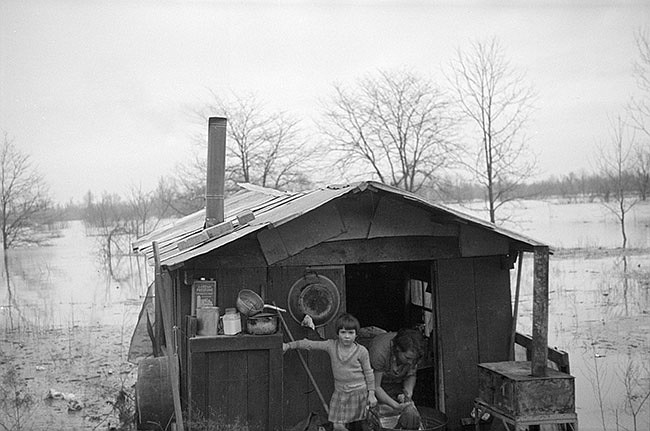The devastating Mississippi River flood of 1927 has deservedly entered the realm of legend and lore, being one of the most costly natural disasters in American history. But 10 years later, Arkansas was on course to repeat history.
Flood conditions developed over January and February 1937 as eastern and western seaboard pressure zones caused moist southern, tropical air masses to thrust northward, while northern polar air masses thrust southward. This combination of colliding elements brought extremely heavy rainfall to 11 states along the Ohio and Mississippi river valleys.
Arkansas recorded 12.61 inches of rain in January -- 8.22 inches above normal. The day before President Franklin Delano Roosevelt's second-term inauguration, floodwaters began surging into Arkansas counties.
Arkansas' floodwaters came from tributary streams no longer able to drain effectively due to the cresting Mississippi River. Specifically, Bayou de View as well as the Black, Cache, L'Anguille, Little Red, Spring, Strawberry, St. Francis, Tyronza and White rivers spilled across agricultural terrain mostly bare of crops that time of year. While the Arkansas River was at flood stage at Van Buren for only one day, the White River exceeded flood stages below Calico Rock, and the St. Francis River had considerable flooding from January into March.
The American Red Cross in Arkansas mobilized local chapter relief efforts between Jan. 10 and 15, with the national office assuming command Jan. 20 and reaching what it classified as a more critical level between Jan. 24 and Feb. 11. Counties needing various levels of rescue operations were Arkansas, Craighead, Crittenden, Cross, Greene, Jackson, Lawrence, Lee, Mississippi, Monroe, Phillips, Poinsett, Prairie, Pulaski, St. Francis, White and Woodruff.
Arkansas' floodwaters inundated 1,037,500 acres of agricultural land and 756,800 acres of other land, affecting 40,916 families and their livestock. To shelter the evacuees, the Red Cross established 75 camps (tent cities) and concentration centers (existing structures) equipped with special livestock corrals.
Twenty-nine field hospitals staffed by 166 nurses tackled the needs of patients and immunized people against typhoid and diphtheria, among other diseases. A tent city near Jonesboro was the only refugee location where disease broke out. Meningitis appeared there Feb. 5, in a child. An emergency isolation hospital was prepared to house the eventual 36 cases, which resulted in 11 deaths.
The U.S. Army, Arkansas National Guard and volunteers prepared twice-daily meals for the displaced. As floodwaters receded and families returned home, baskets of food were distributed. Law and order were the responsibility of the local authorities supplemented by the National Guard. A principal warehouse at Forrest City was established to collect and move materials to the other sites.
Recreation programs were instituted for adults and children at camps and centers. The Works Progress Administration's Federal Theatre Project had a mobile unit that offered a variety show touring Arkansas.
Some eastern Arkansans fled into Memphis, including some who were not in danger. The Memphis Red Cross mobilized 14 camps in schools, the fairgrounds barracks and other available facilities to deal with the influx.
R.S. Hayden, pastor of a Methodist Church in Forrest City, wrote Feb. 3 about the suffering and stress from the floodwaters. The minister said the city housed "15,000 refugees with more coming, plus 20,000 mules, cows, dogs, cats, and chickens." Fleeing citizens were segregated by race into tent cities -- one near the high school and the other by the cotton compress.
In his March 25 letter, J.H. Kirkpatrick, secretary of the Phillips County Chamber of Commerce, thanked the citizens of Benton County "for their hearty response" to the disaster. He announced that "the high water of the Mississippi have [sic] almost disappeared. Over 8,000 refugees have been returned to their homes and farms this past week. The southern part of the county has experienced a very disastrous devastation from high waters, wind and waves."
Eleven-year-old Marvin Howell lived in Manila when the rains hit. He recalled schools being dismissed and how "life came almost to a standstill." His father, a rural mail carrier, continued working while he sent his family to stay with his brother in Memphis. Marvin's recollections included the drive "for miles and miles over the submerged road," eventually crossing the Harahan Bridge into Memphis.
Hardest hit areas in the Flood of 1937 were outside Arkansas; nevertheless, Arkansas suffered the highest human death toll and injury. With aggregate disaster building repair exceeding $5.75 million and the cost of replacing household goods at more than $6.75 million, Arkansas losses in these categories seemed almost trifling. However, rural Arkansas families living along backwater areas suffered greatly, especially agricultural workers, such as sharecroppers and tenant farmers, who saw their meager livelihoods destroyed.
-- John Spurgeon
This story is adapted by Guy Lancaster from the online Encyclopedia of Arkansas, a project of the Central Arkansas Library System. Visit the site at encyclopediaofarkansas.net.
